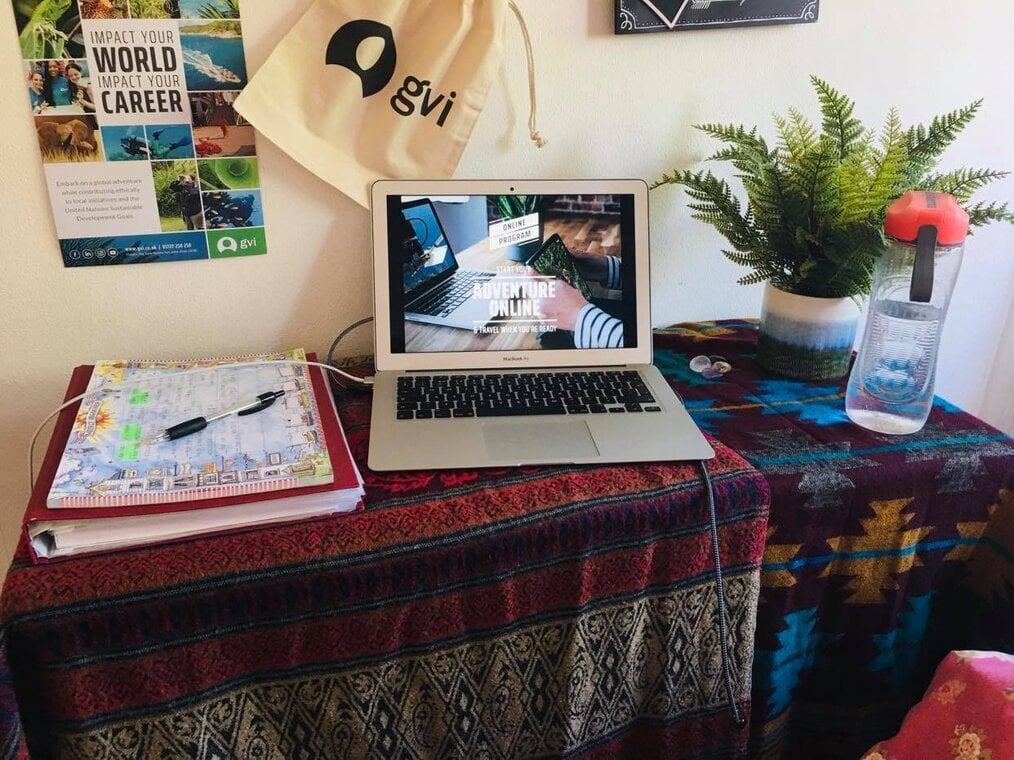How to Choose a Study Abroad Program
For students based in the United States, studying abroad is an exciting opportunity to see the world. But it can be daunting to sift through the hundreds of cities and programs that all sound enticing. This guide will help you narrow down your choices so that you can pick a study abroad program that best suits your needs.

Choosing a study abroad program is a daunting task. We all hear so much about how “studying abroad will change your life” and while there’s a lot to be excited about, there’s also the fear of making a bad decision.
I get it. For years, I’d always imagined studying abroad as a central part of my college experience. The problem was, the specifics changed every time I daydreamed! Sometimes, I imagined learning French in southern France. Other times, I imagined going on a Semester at Sea. There was a lot of pressure to choose the “correct” study abroad program because I knew the experience would impact the rest of my life.
If you’re anything like me, you’re probably a freshman or sophomore in college and struggling to know where to even start when it comes to choosing a study abroad program. Luckily, the steps below should help you make a choice you can be confident in.
8 Steps to Choosing Your Study Abroad Program
There is no one right answer when it comes to choosing a study abroad program. To help narrow down the best programs for you, though, here are some things you should consider.
1. Decide Which Country You Want to Study In

Your first step might feel like the hardest. You need to choose what country you want to study abroad in. If it feels too difficult to narrow things down to a specific country, that’s okay. Try to think of a region or a common factor (like the language) that draws a few countries together.
The easiest way to narrow your choices is to first look at language prerequisites. Many study abroad programs include classes taught at the local institution – which means you need to speak that country’s language.
Sure, I liked the idea of studying abroad in France. But in reality, my French skills were only at a beginner level, and I wouldn’t have felt comfortable taking classes or exams in French.
Do your own self-review of your language skills to help determine which countries, or at least which regions, you are eligible to study abroad in.
If you’re fluent in a foreign language, then you may feel comfortable looking at programs where you’ll be directly enrolled in the local university.
If you’re not proficient in a language other than English, don’t worry. There are plenty of English-speaking countries, like England, South Africa, Australia, New Zealand, and others where you can study abroad through direct enrollment in local universities. Plus there are many other countries that offer robust programs in English, such as Denmark, Sweden, and Germany.
There are also plenty of programs that don’t actually have a language prerequisite, due to the way the program is run. These programs are typically offered through a third party (like IES Abroad or CEA Study Abroad). Because these programs are specifically geared for international students, they tend to have more English programs in countries where English isn’t the native language.
If you’re at the opposite end of the spectrum and you don’t have any countries in mind that you want to study abroad in, then it’s time to get inspired. Explore study abroad Instagram accounts (like @GoOverseas), browse Pinterest, or look through the brochures at your college’s study abroad office.
2. Look at Programs That Fit Your Major

There’s a huge variety of study abroad programs out there, from month-long language exchange programs, to year-long programs, to online study abroad programs. To help guide your search, though, try to focus on programs that fit your major.
The positive news is there are study abroad programs for pretty much every major! You can browse study abroad programs for business majors, education majors, fashion majors, and so many others. There are even pre-med study abroad programs, as well as programs in many other majors that stereotypes might tell you “can’t” study abroad.
If you want to look beyond an online search, you can also head to your home institution’s study abroad office to get their advice. Your department chair also likely has advice on the best program for your major.
And don’t worry… you don’t have to study abroad in the same department as your major! A semester study abroad in an area you’re passionate about can be a great opportunity to branch out and make your college experience feel a bit more well-rounded.
3. Choose How Long You Want to Study Abroad

After you’ve narrowed your search down to a few countries or programs, it’s time to consider what length of study abroad program you want to do. As you know, study abroad programs come in many shapes and sizes, ranging from a few weeks to a full year.
Here are a few of the program lengths you might find, and the pros and cons of each:
Summer or Short-term:
Pros: Due to the short length, this is usually the cheapest option for a study abroad program. Since it’s over the summer, it also means you won’t feel like you’re missing out on seeing your college friends, engaging in campus life, or taking mandatory classes at your home institution.
Cons: With only a few weeks or months abroad, this isn’t the most immersive option. It will be a whirlwind, and you might find it harder to make friends abroad, travel during your program, or become conversational in the local language.
Semester:
Pros: This length is a happy medium that will make you feel reasonably immersed in the local culture and life, but not like you’re missing out on too much at your home institution. You’ll likely have time to travel over fall or spring breaks, too.
Cons: A semester can still feel surprisingly short, and before you know it you’ll be saying goodbye to new friends. You also might feel like you have to jam lots of travel into just one semester. When you return to your home institution for your other semester, many of your friends might be away on their own study abroad semesters.
Year:
Pros: A full year is definitely the most immersive study abroad experience. It gives you time to become conversational, to make local friends, explore the culture, and travel – without being too stressed about an impending departure date.
Cons: Year-long study abroad programs are the most expensive. It can also be complicated to coordinate academic credit transfers, and you might feel like you’re missing out on campus life at your home institution.
Personally, I opted to do a year-long study abroad program and I’m so happy that I did! I was nervous because I didn’t want to miss out on life at my college at home. And while I did miss out on some things, I don’t regret it because I had so much time to travel, get involved in life abroad, and make best friends that I’m still close with to this day. I even got to meet up with some of my friends from home on weekend trips in Europe while they were also studying abroad nearby.
4. Consider How “Hands-On” You Want Your Study Abroad Program To Be

This is an often-overlooked factor, but it’s important to consider how much support you want during your program.
Some study abroad programs are very hands-on, with weekend excursions and dedicated staff who are either part of the third party program or also traveled from your home institution. Other programs are just like you’re enrolled in the local university the same as any other student. There are clearly benefits and drawbacks to each option.
Lots of support is great if you haven’t traveled much before, or if you’re nervous about going abroad. More independent programs are ideal if you’re feeling confident and want to challenge yourself to really get involved like a local student.
5. Make Sure You Can Transfer Credits Back to Your Home University

I know it’s fun to dream about all the travel you’re going to do and the life you’re going to have abroad, but there are also some practicalities you need to consider. It’s important to ensure that the academic credits you earn on your study abroad program can be transferred back to your home institution so that you can graduate on time.
Academic credits and transfers definitely sound complicated but take a deep breath. Keep in mind that most universities see study abroad as a positive experience that can advance you academically, personally, and professionally. They will do their best to make sure your credit is counted!
At this point, you’ll probably have a list of programs in whatever country you choose. Now it’s time to take these programs to your home institution’s study abroad office and be sure that the credit is transferable.
Most universities have a list of partner institutions abroad. These are obviously the easiest to transfer credit between. Even so, many universities will also accept credit transfers from non-affiliated institutions or programs, but they may need to do some paperwork first.
Be sure to ask if there’s a cap on credits you can earn if you’re going to have issues fulfilling your major’s requirements, and any paperwork you need to complete before you go overseas.
6. Explore Financial Aid Packages

The next step is another pretty big practicality: financial aid! Study abroad programs can range in price from actually being less expensive than your home institution’s tuition, to being, well, a lot more.
Thankfully, there are tons of resources for study abroad financial aid if the cost of the program you’ve selected is prohibitive.
Your first port of call should definitely be your selected study abroad program itself – many programs have dedicated scholarships for students each semester. Reach out to the program lead by email and ask their advice.
It’s also useful to look for scholarships from organizations outside your specific program. Here are 42 study abroad scholarships and grants available in 2020. Go Overseas also offers a range of scholarships, totaling $100,000 per year, that are worth checking out!
Some other options for financial aid include federal financial aid, or even financial aid from the government of the country you plan to study in. You can also Google study abroad scholarships by demographic or qualities – there are many study abroad scholarships specific to women, religious groups, minorities, field of study, and more.
7. Read Reviews and Talk to Previous Study Abroad Students

By this step, you’ve likely narrowed down your options significantly. But chances are, you’re still torn between a couple of programs. Personally, I narrowed myself down to just one year-long study abroad program – but I still felt hesitant to take the plunge because it felt like such a monumental decision. I just wanted to feel more confident in my choice.
If you’re feeling like I was, then I recommend checking out online reviews of the specific study abroad program you’re interested in. You can search your program on Go Overseas and read tons of reviews, and even filter to the most recent ones. Reading just a few reviews can help you confirm you’re on the right track.
It’s also helpful to actually talk to students who’ve done that exact program before. Chat to your university’s study abroad office and see if they can connect you.
My own attitude completely changed once I had the chance to meet with a group of students who’d done my study abroad program the previous year. They helped settle my specific worries about being abroad for a full year, made me feel confident in my choice, and helped me get excited for the adventure that was ahead of me!
8. Bonus: Consider an Online Study Abroad Program

Last but not least, be sure to expand your horizons to online study abroad programs. Yes – that’s a thing!
While this may not be the traditional idea of studying abroad, there are many benefits to an online program that might make it a compelling option for you. Online programs tend to be flexible, accessible, and much less expensive than their in-person counterparts. Some programs will offer hybrid options, so it’s worth the effort of looking into virtual study abroad programs to see how they may work for you.
There Are No Wrong Choices

I know first-hand how overwhelming it feels to choose a study abroad program. In some ways, I felt like by making a choice, I was closing off other opportunities and alternate life paths.
Looking back, though, I know that the most important thing was not getting my choice exactly “right,” but rather going overseas with an open mind to the new culture and lifelong friends I was about to meet. Years later I can say that studying abroad was one of the best decisions I have ever made. Soon, you’ll be able to say the same!
